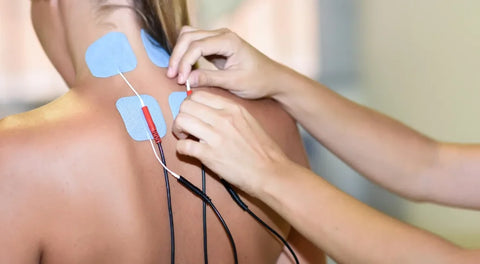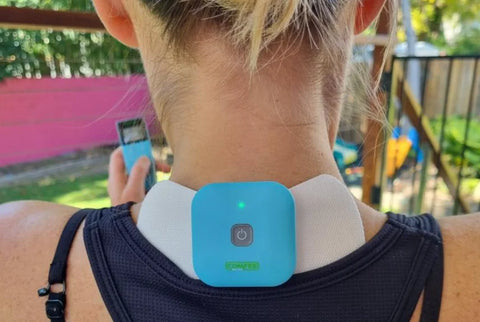Living with fibromyalgia means dealing with constant pain, relentless fatigue, and tender spots on your body that can make even the most straightforward task challenging. Finding relief requires a lot of trial and error, and one method that's recently gained traction is using a TENS machine.
TENS units, short for Transcutaneous Electrical Nerve Stimulation, use low-voltage electrical currents to ease fibromyalgia pain without needing drugs or surgery. This guide will help you understand how TENS machines work for fibromyalgia - exploring the science behind TENS therapy, how they target the pain, and providing practical advice on properly using these devices.
The goal is to help you understand how a TENS machine for fibromyalgia can offer you relief and control over this challenging condition.
What is Fibromyalgia?
Fibromyalgia is a bit of a medical puzzle—it's a chronic condition characterised by widespread musculoskeletal pain, accompanied by fatigue, sleep, memory, and mood issues.
Imagine your body as a network of pain signals, and in fibromyalgia, it's as if the volume's been turned way up. The exact cause isn't known, but your brain's pain receptors develop a sort of memory of the pain and become sensitised, making you more reactive to pain signals.
Symptoms of Fibromyalgia
The body is like an overactive alarm system, when it comes to fibromyalgia. Pain and tender points across the body are the hallmarks, but the symptoms go beyond that.
People with fibromyalgia may experience deep tissue pain, muscle spasms, or tightness. They often feel fatigued even after sleeping for hours—sleep is frequently disrupted by pain, and many also suffer from sleep disorders like restless legs syndrome or sleep apnea.
Cognitive difficulties, commonly known as "fibro fog," affect the ability to focus, pay attention, and concentrate on tasks. Some individuals might also deal with headaches, depression, or anxiety.
Conventional Treatment Options for Fibromyalgia
Treating fibromyalgia isn't one-size-fits-all; it's more like tailoring a suit to fit perfectly. Medications like pain relievers, antidepressants, and anti-seizure drugs are commonly prescribed.
However, physical therapy can be a game-changer, and a TENS machine for fibromyalgia offers a non-invasive way to dial down the pain. It sends electrical impulses through the skin to tweak the nervous system, turning down the pain signal volume.
Benefits of Using a TENS Machine for Fibromyalgia

TENS machines, also known as Transcutaneous Electrical Nerve Stimulation devices, bring several benefits for managing fibromyalgia symptoms without invasive methods or medication. Here's how they can help -
Pain Relief
When it comes to fibromyalgia, every day can feel like a battle against pain. These machines work by stopping pain signals before they reach the brain, which helps lessen how much pain you feel. They're a safe way to manage ongoing discomfort, allowing people with fibromyalgia to do daily activities with less pain.
Muscle Relaxation
Fibromyalgia often makes muscles tense and spasm. TENS machines help relax these muscles by stimulating nerves, making them less anxious. It helps promote relaxation and ease that wound-up feeling you might experience.
Improved Circulation
The electrical pulses from a TENS machine can improve blood flow in specific areas. This better circulation can speed healing and reduce muscle soreness common in fibromyalgia. With more blood flow, affected areas get more nutrients and oxygen, making you feel better overall.
Reduced Inflammation
Inflammation can exacerbate fibromyalgia symptoms. While a TENS machine isn't a cure, it can help manage the condition by reducing inflammation. The electrical pulses might lessen swelling and irritation in the soft tissues, temporarily relieving inflammatory pain.
Enhanced Endorphin Production
TENS machines for fibromyalgia can also prompt the body to release endorphins, which are natural painkillers. A TENS machine for fibromyalgia can stimulate the release of these hormones, leading to a natural and pleasant pain-relieving effect. It might lift your mood and make the pain feel less intense.
Selecting the Right TENS Machine for Fibromyalgia
When you're dealing with fibromyalgia, finding relief from persistent pain depends on picking the suitable machine to fit your lifestyle and pain management needs. Knowing their differences with several options on the market will help you choose wisely.
Factors to Consider When Choosing a TENS Machine
When browsing for a tens machine for fibromyalgia, there are several factors to weigh. Consider the machine's intensity levels—having a good range is essential for fibromyalgia's fluctuating pain.
Size and battery life are also important; a compact, long-lasting machine is best for consistent relief. Lastly, check for a user-friendly interface to make your pain management journey as smooth as possible.
Portable vs. Non-portable TENS Machines
A portable TENS unit lets you move around and go about your day while getting treatment. They're usually light, discreet, and great for on-the-go lifestyles. Non-portable models, while less mobile, might have more power or extra features. Depending on your daily routine and pain levels, one may be more suitable than the other.
Single-channel vs. Dual-channel TENS Machines
Single-channel TENS units for fibromyalgia focus on one area at a time, which is good for specific pain. But dual-channel ones can tackle multiple pain points at once, which is helpful for widespread fibromyalgia discomfort.
Preset Programs vs. Customisable Settings
Some TENS machines have preset programs for different types of pain, like fibromyalgia. These are handy, but if you want more control, look for one with customisable settings. That way, you can adjust the intensity and frequency to match your pain levels better, making your experience more personalised.

Using a TENS Machine for Fibromyalgia
Learning how to use a TENS machine properly involves thoroughly understanding its settings, placement of electrodes, and duration of sessions. Here are a few simple steps to get you started -
Setting up the TENS Machine
Are you new to the world of TENS therapy? Start by gathering all the parts: the machine, wires, and electrodes. Insert or charge its batteries, connect the cables to the device, and attach the electrodes.
Applying the Electrodes
Next, focus on where to place the electrodes—they shouldn't go directly on the painful area but around it. Cleaning the skin beforehand helps the electrodes stick better and work properly.
Adjusting the Intensity and Frequency of the Pulses
Once set up, it's time to adjust the intensity and frequency of the electrical pulses. Your TENS machine will likely have buttons or dials for this.
Start with the lowest setting and slowly increase it until you feel a firm but comfortable sensation—think of it like a soothing buzz, not a painful shock. Experiment with different settings to find what works best to relieve pain.
Tips for Maximising Pain Relief
Use the TENS machine regularly but in short sessions of 20-30 minutes a few times daily for the best results. Try to relax during treatment and find a comfortable position. While TENS can be helpful, it's just one part of managing fibromyalgia. Talk to your healthcare provider for a comprehensive approach to managing your condition.
Bottom Line
Using a TENS machine for fibromyalgia offers a promising avenue for managing the chronic pain associated with this condition. TENS tools can ease the deep muscle pain that comes with fibromyalgia by sending low-voltage electrical currents to the affected areas and potentially improving the quality of life for those affected.
For those seeking a reliable and effective TENS unit, consider Comfee Relief—a brand dedicated to providing high-quality pain management solutions. Their TENS machines are designed for the user's comfort and ease of use, helping individuals receive pain relief with minimal hassle.
